Your Cart is Empty
Your BDSM Session checklist or how to plan a BDSM scene
27-01-2019 - Written by Jett Oxy
How to plan a BDSM Scene?
Kinky sex offers several foreplay opportunities, and this is one of the significant differences between kink and non-kink sexual encounters. Several actions could be included which might be impossible to achieve ordinarily. For instance, while having a romantic foreplay with someone, I can determine if the person will like to advance into the intercourse proper. The same instinct cannot be used in the case of kinky actions – you simply cannot rely on body language to know if your partner is interested or how much interest they have. The best is usually to discuss what you would like to do, and what you want to avoid – either during a lengthy talk or a brief conversation. Whichever way, the most important thing is that it should happen.
Source: Wikipedia
Most partners engaging in BDSM for the first time do have challenges trying to plan on how they want the whole session to go.
Yes, planning such scenes can be quite personal, however, we have prepared the guideline below to help you plan better.

Begin by creating your goals
You have to decide on your expectations and the roles of each partner, as well as what you would like to achieve in the end. Once these are known, you can work on the activities that will come in between, and reasons why they have to happen. You can get some useful tips by watching porn and reading erotica. Ensure that you both are clear on whether you are restricting the session to a specific action or taking it all. If you're new to BDSM, here's all you need to know about BDSM to get started.
Source: Submissiveguide
Integrate your goals in designing a scene; get a consent
After you have figure out your goals, there is a need to check the actions which each person will give his/her permission to, the desired intensity level of individuals, the pleasant feelings and scene-spoilers, and the kind of sexual and physical contacts you both find comfortable. Also, at this stage, you should discuss the limits and the actions you would not like to perform in some specific scenes. It is best that you are serious with this part of the planning, so that you don’t end up missing out the vital information that your partner should know. And since they are not aware, they may engage in such and get you hurt badly. Moving forward, below are some of the usual limits:
- Transmission of disease via unsafe sex
- A feeling of humiliation or unworthiness
- Presence/absence and types of physical marks
- Actions that can trigger your previous traumatic memories
- Blood
- Feelings of excessive exposure or claustrophobic feelings.
- Piss or shit – also known as Golden shower, scat, or water sports
- Unsafe feelings or the fear of your partner
- Specific kind of pains; pains in particular places or intensity of pain.
Take your time to think about a feeling that makes you feel uncomfortable, and inform your partner of the same. You must both be in the know of such, so that in the end one of you wouldn't come up with an action that might provoke the other, and claim that the partner didn't say it was his/her limit. Hence, think and talk about all your boundaries. For those interested in exploring impact play, here's everything you need to know about impact play in BDSM.
Be slow and steady
Don't rush actions. It is inadvisable to start with 100 strokes if you have never been tied to be flogged before. You can begin with ten strokes to have an idea of how it feels. You are free to do more if it feels good. If you're interested in exploring restraints, here's a bondage restraints guide for beginners.
Source: Kinkdapp
Communicate with your partner
You have to communicate clearly, for everyone’s safety. And also, communication is essential to ensure that your partner agrees to all the actions. Endeavor to have a verbal and non-verbal way of indicating stress. Verbal approaches involve using ordinary language such as “it’s enough” or the use of safe-words (which you should have discussed earlier). It is better to use words that are simple and can be easily remembered, such as “Red,” and the use of casual words which means distress like “no,” “wait,” or “stop” if you are engaging in the act as a beginner.
As for the non-verbal signs, some of the most common signals are:
- Dropping an object
- Noise making by tapping a button
- Snapping fingers
- Grunting
It is crucial to have non-verbal signals, especially in a situation where your partner won’t be able to speak audibly when you use loud music or gag.
In addition to communication, body language is also important. You have to tell your partner how you behave when in distress. Behaviors such as flopping, shaking, crying, or tensing up are some of the common signs of trouble and should be watched out for in a situation where a sub gets excessively upset to talk openly. Ensure that you check in on your partner to make sure that he/she is okay in such situations. Checking in is crucial, so that you can be on the same page with your partner. Likewise, having a mutually understood body language that indicates distress or panic is also great. There should be safe words to check on your partner when you feel that their body language is indicating that they are not okay. If you're new to the submissive role, here's a guide to start your sub journey as a novice submissive.
Source: Rekink
You can use easy statements like “are you alright” to check on your partner; however, you can also use name of colors such as Red (meaning to stop all events), Yellow (that is you are on the limit), or green (everything is fine) if you don’t want to spoil the fun. The use of a scale of 1-10 can also be used to rate feelings’ intensity between you and your partner. This, however, will require a pre-conceived maximum limit, set by a number from 1-10.You can have your partner participate actively in specific parts of the scene. For instance, having them repeat after you, getting those toys, or demanding them to answer questions in the course of the session. All these interactions, when done properly, will ensure that you both get the best mental and sensual feeling out of the session.

Discuss basic health information
You have to talk about health details such as limits of sexual contacts, or if anyone of you has health challenges that can influence the scene. It is necessary to inform your partner if you are in a bad mood or had a tedious day, because the state of your mood will play a massive part in how you play. Reveal any aftercare that you will need to remain physically and mentally okay after the play – some people do need a talk, cuddle, or snack afterward.While long-term and experienced partners might not necessarily have to discuss every time they want to play, it is best advised to review these discussions. For instance, you can gain a lot by concentrating on your most favorite activities, and present state of comfort for partners that already know each other well enough.Do have a wonderful and of course pleasurable moment in your next BDSM Session!
Article Written by Jett Oxy for oxy-shop.com.
Jett is the owner of Oxy-shop.com, a BDSM insider, a sex educator and writer.
"I always try to explore the confines of the BDSM world and bring valuable insights for new comers joining our adventure"
PhD in related field, father and business owner, Jett Oxy brings you stories and advices for educational and entertainment purposes.

